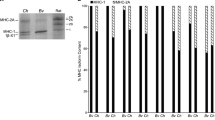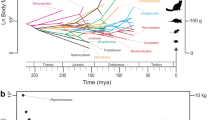Abstract
Using immunohistochemistry and SDS-PAGE, we studied the myosin heavy chain (MyHC) composition and fibre type distribution of hindlimb muscles of hopping and non-hopping Australian marsupials. We showed that hindlimb muscles of a bandicoot (Isoodon obesulus, order Peramelomorphia) and a small macropodoid, the brushtail bettong (Bettongia penicillata) expressed four MyHCs, slow, 2a, 2x and 2b, and had the corresponding fibre types as other macropods reported earlier. The fastest and most powerful 2b fibres predominated in most bettong hindlimb muscles, but were absent in the gastrocnemius and the flexor digitorum profundus, which are involved in elastic strain energy saving during hopping. The gastrocnemius of four large macropodids also showed little or no 2b MyHC, whereas this isoform was abundant in their tibialis anterior, which is not involved in elastic energy saving. In contrast, 2b MyHC predominated in the gastrocnemius of four non-hopping marsupials. These results suggest that absence of 2b fibres may be a general feature of macropodoid muscles involved in elastic energy saving. Large eutherians except llamas and pigs also have no 2b fibres. We hypothesize that 2x and 2a fibres perform better than 2b fibres in the storage and recovery of kinetic energy during locomotion in both marsupials and eutherians.







Similar content being viewed by others
Abbreviations
- Add:
-
Adductor magnus
- Bicep:
-
Biceps femoris
- Caud:
-
Caudofemoralis
- Cocc:
-
Coccygeus
- Edl:
-
Extensor digitorum longus
- Fdp:
-
Flexor digitorum profundus
- Gas:
-
Gastrocnemius
- mAbs:
-
Monoclonal antibodies
- MyHC:
-
Myosin heavy chain
- Sem:
-
Semitendinosus
- Sol:
-
Soleus
- Ta:
-
Tibialis anterior
References
Arguello A, Lopez-Fernandez JL, Rivero JL (2001) Limb myosin heavy chain isoproteins and muscle fiber types in the adult goat (Capra hircus). Anat Rec 264:284–293
Armstrong RB (1978) Properties and distributions of the fibre types in the locomotory muscles of mammals. In: Ed Schmidt-Nielson K, Bolis L, Taylor CR (eds) Comparative physiology: primitive mammals. Cambridge University Press, New York, pp 243–254
Bar A, Pette D (1988) Three fast myosin heavy chains in adult rat skeletal muscle. FEBS Lett 235:153–155
Baudinette RV, Snyder GK, Frappell PB (1992) Energetic cost of locomotion in the tammar wallaby. Am J Physiol 262:R771–R778
Bennet MB (1987) Fast locomotion of some kangaroos. J Zool 212:457–464
Bennett MB (2000) Unifying principles in terrestrial locomotion: do hopping Australian marsupials fit in? Physiol Biochem Zool 73:726–735
Biewener AA (1998) Muscle-tendon stresses and elastic energy storage during locomotion in the horse. Comp Biochem Physiol B 120:73–87
Biewener AA, Konieczynski DD, Baudinette RV (1998) In vivo muscle force-length behavior during steady-speed hopping in tammar wallabies. J Exp Biol 201:1681–1694
Bottinelli R, Schiaffino S, Reggiani C (1991) Force–velocity relations and myosin heavy chain isoform compositions of skinned fibres from rat skeletal muscle. J Physiol 437:655–672
Bottinelli R, Canepari M, Reggiani C, Stienen GJM (1994) Myofibrillar ATPase activity during isometric contraction and isomyosin composition in rat single skinned muscle fibres. J Physiol 481:663–675
Cavagna GA, Franzetti P, Heglund NC, Willems P (1988) The determinants of the step frequency in running, trotting and hopping in man and other vertebrates. J Physiol 399:81–92
Dawson TJ, Taylor CR (1973) Energetic cost of locomotion in kangaroos. Nature 246:313–314
Dennington S, Baldwin J (1988) Biochemical correlates of energy metabolism in muscles used to power hopping by kangaroos. Aust J Zool 36:229–240
Elftman HO (1929) Functional adaptations of the pelvis in marsupials. Bull Am Mus Nat Hist 58:189–231
Ennion S, Pereira JS, Sargeant AJ, Young A, Goldspink G (1995) Characterization of human skeletal muscle fibres according to the myosin heavy chains they express. J Muscle Res Cell Motil 16:35–43
Gorza L (1990) Identification of a novel type 2 fiber population in mammalian skeletal muscle by combined use of histochemical myosin ATPase and anti-myosin monoclonal antibodies. J Histochem Cytochem 38:257–265
Graziotti GH, Rios CM, Rivero JL (2001) Evidence for three fast myosin heavy chain isoforms in type II skeletal muscle fibers in the adult llama (Lama glama). J Histochem Cytochem 49:1033–1044
Hamalainen N, Pette D (1993) The histochemical profiles of fast fiber Type-IIB, Type-IID, and Type-IIA in skeletal muscles of mouse, rat, and rabbit. J Histochem Cytochem 41:733–743
Hill AV, Howarth JV (1959) The reversal of chemical reactions in contracting muscle during an applied stretch. Proc Roy Soc B 151:169–193
Hoh JFY (1992) Muscle fiber types and function. Curr Opin Rheumatol 4:801–808
Infante AA, Klaupiks D, Davies RE (1964) Adenosine triphosphate: changes in muscles doing negative work. Science 144:1577–1578
Katz B (1939) The relation between force and speed in muscle contraction. J Physiol 96:201–218
Lefaucheur L, Ecolan P, Plantard L, Gueguen N (2002) New insights into muscle fiber types in the pig. J Histochem Cytochem 50:719–730
Linari M, Woledge RC, Curtin NA (2003) Energy storage during stretch of active single fibres from frog skeletal muscle. J Physiol 548:461–474
Lombardi V, Piazzesi G (1990) The contractile response during steady lengthening of stimulated frog muscle fibres. J Physiol 431:141–171
Lucas CA, Kang LH, Hoh JF (2000) Monospecific antibodies against the three mammalian fast limb myosin heavy chains. Biochem Biophys Res Commun 272:303–308
Maccatrozzo L, Patruno M, Toniolo L, Reggiani C, Mascarello F (2004) Myosin heavy chain 2B isoform is expressed in specialized eye muscles but not in trunk and limb muscles of cattle. Eur J Histochem 48:357–366
Rivero JL, Serrano AL, Barrey E, Valette JP, Jouglin M (1999) Analysis of myosin heavy chains at the protein level in horse skeletal muscle. J Muscle Res Cell Motil 20:211–221
Schiaffino S, Gorza L, Sartore S, Saggin L, Ausoni S, Vianello M, Gundersen K, Lomo T (1989) Three myosin heavy chain isoforms in type 2 skeletal muscle fibres. J Muscle Res Cell Motil 10:197–205
Sciote JJ, Rowlerson A (1998) Skeletal fiber types and spindle distribution in limb and jaw muscles of the adult and neonatal opossum, monodelphis domestica. Anat Rec 251:548–562
Smerdu V, Karschmizrachi I, Campione M, Leinwand L, Schiaffino S (1994) Type IIx myosin heavy chain transcripts are expressed in type IIb fibers of human skeletal muscle. Amer J Physiol Cell Physiol 36:C1723–C1728
Talmadge RJ, Roy RR (1993) Electrophoretic separation of rat skeletal muscle myosin heavy-chain isoforms. J Appl Physiol 75:2337–2340
Talmadge RJ, Grossman EJ, Roy RR (1996) Myosin heavy chain composition of adult feline (Felis catus) limb and diaphragm muscles. J Exp Zool 275:413–420
Tanabe R, Muroya S, Chikuni K (1998) Sequencing of the 2a, 2x, and slow isoforms of the bovine myosin heavy chain and the different expression among muscles. Mammal Genome 9:1056–1058
Termin A, Staron RS, Pette D (1989) Changes in myosin heavy chain isoforms during chronic low-frequency stimulation of rat fast hindlimb muscles. A single-fiber study. Eur J Biochem 186:749–754
Toniolo L, Patruno M, Maccatrozzo L, Pellegrino MA, Canepari M, Rossi R, D’Antona G, Bottinelli R, Reggiani C, Mascarello F (2004) Fast fibres in a large animal: fibre types, contractile properties and myosin expression in pig skeletal muscles. J Exp Biol 207:1875–1886
Webster KN, Dawson TJ (2003) Locomotion energetics and gait characteristics of a rat-kangaroo, Bettongia penicillata, have some kangaroo-like features. J Comp Physiol [B] 173:549–557
Zhong WWH (2005) A study on fibre types and myosin isoforms of cardiac and skeletal muscles of Australian marsupials. Department of Physiology. University of Sydney, Sydney
Zhong WW, Lucas CA, Kang LH, Hoh JF (2001) Electrophoretic and immunochemical evidence showing that marsupial limb muscles express the same fast and slow myosin heavy chains as eutherians. Electrophoresis 22:1016–1020
Acknowledgments
This work was supported by a grant from the National Health and Medical Research Council and the Australian Research Council. WWHZ is a recipient of the Faculty of Medicine Postgraduate Scholarship of the University of Sydney. We thank Prof. Terry Dawson and Dr Koa Webster of the University of NSW, Dr Kerry Withers of the University of Southern Queensland, Dr Stephen MacLeod of Macquarie University-Sydney, Dr Peter Runham of the University of Western Australia, and David Blyde of the Western Plains Zoo, NSW, for providing tissue samples. The experiments were done with the approval of the Animal Ethics Review Committee of the University of Sydney and comply with the current laws governing animal experimentation in Australia.
Author information
Authors and Affiliations
Corresponding author
Additional information
Communicated by I.D. Hume.
Rights and permissions
About this article
Cite this article
Zhong, W.W.H., Lucas, C.A. & Hoh, J.F.Y. Myosin isoforms and fibre types in limb muscles of Australian marsupials: adaptations to hopping and non-hopping locomotion. J Comp Physiol B 178, 47–55 (2008). https://doi.org/10.1007/s00360-007-0198-8
Received:
Revised:
Accepted:
Published:
Issue Date:
DOI: https://doi.org/10.1007/s00360-007-0198-8




